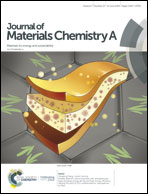Superior fracture resistance of fiber reinforced polyampholyte hydrogels achieved by extraordinarily large energy-dissipative process zones†
Abstract
Fiber reinforced soft composites (FRSCs) have been developed recently by combining tough but soft polyampholyte hydrogels with stiff yet flexible woven glass fabrics. In this work, we find that the soft composites show increased tearing resistance with sample size and achieve size-independent, exceptionally high tearing energy above a specific size on the centimeter scale. Such size-dependent tearing behavior correlates with the failure mode change from fiber pull-out to fiber fracture. These findings demonstrate that the rigid fibers in the soft matrices transmit force over a large distance, giving the composites very large process zones. Tremendous energy is dissipated in the large process zones, resulting in the superior fracture resistance of FRSCs. By saturation of the process zone size, the soft composites become extraordinarily tough, showing an intrinsic tearing energy of ∼1000 kJ m−2 that outperforms other existing tough materials. These novel FRSC materials from hydrated biocompatible hydrogels fill the gap between soft materials and traditional rigid materials, as demonstrated by their high tensile modulus (several GPa) and strength (>300 MPa), along with exceptionally high tearing toughness.



 Please wait while we load your content...
Please wait while we load your content...